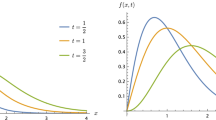Abstract
The Gauss–Diffusion processes are here considered and some relations between their infinitesimal moments and mean and covariance functions are remarked. The corresponding linear stochastic differential equations are re-written specifying the coefficient functions and highlighting their meanings in theoretical and application contexts. We resort the Doob-transformation of a Gauss–Markov process as a transformed Wiener process and we represent some time-inhomogeneous processes as transformed Ornstein–Uhlenbeck process. The first passage time problem is considered in order to discuss some neuronal models based on Gauss–Diffusion processes. We recall some different approaches to solve the first passage time problem specifying when a closed-form result exists and numerical evaluations are required when the latter is not available. In the contest of neuronal modeling, relations between firing threshold, mean behavior of the neuronal membrane voltage and input currents are given for the existence of a closed-form result useful to describe the firing activity. Finally, we collect in an unified way some models and the corresponding Gauss–Diffusion processes already considered by us in some previous papers.
Similar content being viewed by others
Notes
The initial condition together with (ii) and (iii) implies \(h_1(t_0)=0\) and \(r(t_0)=0\).
With this factorization choice the function r(t) preserves the unit of measurement of time t.
References
Benda, J., Herz, A.V.M.: A universal model for spike-frequency adaptation. Neural Comput. 15, 2523–2564 (2003)
Bulsara, A.R., Elston, T.C., Doering, C.R., Lowen, S.B., Linderberg, K.: Cooperative behavior in periodically driven noisy integrate-fire models of neuronal dynamics. Phys. Rev. E 53(4), 3958–3969 (2011)
Burkitt, A.N.: A review of the integrate-and-fire neuron model: I. Homogeneous synaptic input. Biol. Cybern. 95, 1–19 (2006)
Buonocore, A., Caputo, L., Pirozzi, E.: On the evaluation of firing densities for periodically driven neuron models. Math. Biosci. 214, 122–133 (2008)
Buonocore, A., Caputo, L., Pirozzi, E., Ricciardi, L.M.: On a stochastic leaky integrate-and-fire neuronal model. Neural Comput. 22, 2558–2585 (2010)
Buonocore, A., Caputo, L., Pirozzi, E., Ricciardi, L.M.: The first passage time problem for gauss-diffusion processes: algorithmic approaches and applications to lif neuronal model. Methodol. Comput. Appl. Prob. 13, 29–57 (2011)
Buonocore, A., Caputo, L., Pirozzi, E., Carfora, M.F.: Gauss-diffusion processes for modeling the dynamics of a couple of interacting neurons. Math. Biosci. Eng. 11, 189–201 (2014)
Buonocore, A., Caputo, L., Nobile, A.G., Pirozzi, E.: Gauss–Markov processes in the presence of a reflecting boundary and applications in neuronal models. Appl. Math. Comput. 232, 799–809 (2014)
Buonocore, A., Caputo, L., Nobile, A.G., Pirozzi, E.: Restricted Ornstein–Uhlenbeck process and applications in neuronal models with periodic input signals. J. Comput. Appl. Math. 285, 59–71 (2015)
Buonocore, A., Caputo, L., Nobile, A.G., Pirozzi, E.: Gauss–Markov processes for neuronal models including reversal potentials. Adv. Cogn. Neurodyn. (IV) 11, 299–305 (2015)
Daniels, H.E.: The minimum of a stationary Markov process superimposed on a U-shaped trend. J. Appl. Probab. 6, 399–408 (1969)
Di Nardo, E., Nobile, A.G., Pirozzi, E., Ricciardi, L.M.: A computational approach to first passage-time problems for Gauss–Markov processes. Adv. Appl. Probab. 33, 453–482 (2001)
Gerstein, G.L., Mandelbrot, B.: A random walk models for the Spyke activity of a single neuron. Biophys. J. 4, 41–68 (1964)
Giorno, V., Nobile, A.G., Ricciardi, L.M.: On the asymptotic behaviour of first-passage-time densities for one-dimensional diffusion processes and varying boundaries. Adv. Appl. Probab. 22(4), 883–914 (1990)
Gluss, B.: A model for neuron firing with exponential decay of potential resulting in diffusion equations for probability density. Bull. Math. Biol. 29(2), 233–243 (1967)
Kim, H., Shinomoto, S.: Estimating nonstationary inputs from a single spike train based on a neuron model with adaptation. Math. Biosci. Eng. 11, 49–62 (2014)
Kostur, M., Schindler, M., Talkner, P., Hänggi, P.: Neuron firing in driven nonlinear integrate-and-fire models. Math. Biosci. 207, 302–311 (2007)
Lánský, P.: Sources of periodical force in noisy integrate-and-fire models of neuronal dynamics. Phys. Rev. E 55(2), 2040–2043 (1997)
Ricciardi, L.M., Di Crescenzo, A., Giorno, V., Nobile, A.G.: An outline of theoretical and algorithmic approaches to first passage time problems with applications to biological modeling. Math. Jpn. 50(2), 247–322 (1999)
Schindler, M., Talkner, P., Hänggi, P.: Escape rates in periodically driven Markov processes. Phys. A 351, 40–50 (2005)
Shinomoto, S., Sakai, Y., Funahashi, S.: The Ornstein–Uhlenbeck process does not reproduce spiking statistics of neurons in prefrontal cortex. Neural Comput. 11, 935–951 (1999)
Stein, R.B.: A theoretical analysis of neuronal variability. Biophys. J. 5, 173–194 (1965)
Stevens, C.F., Zador, A.M.: Novel integrate-and-fire-like model of repetitive firing in cortical neurons. In: Proceedings of the 5th Joint Symposium on Neural Computation (1998)
Taillefumier, T., Magnasco, M.0.: A phase transition in the first passage of a Brownian process through a fluctuating boundary: implications for neural coding. PNAS E1438–E1443 (2013). doi:10.1073/pnas.1212479110
Author information
Authors and Affiliations
Corresponding author
Additional information
Communicated by Salvatore Rionero.
To the memory of prof. Carlo Ciliberto.
Rights and permissions
About this article
Cite this article
Buonocore, A., Caputo, L., D’Onofrio, G. et al. Closed-form solutions for the first-passage-time problem and neuronal modeling. Ricerche mat. 64, 421–439 (2015). https://doi.org/10.1007/s11587-015-0248-6
Received:
Revised:
Published:
Issue Date:
DOI: https://doi.org/10.1007/s11587-015-0248-6




